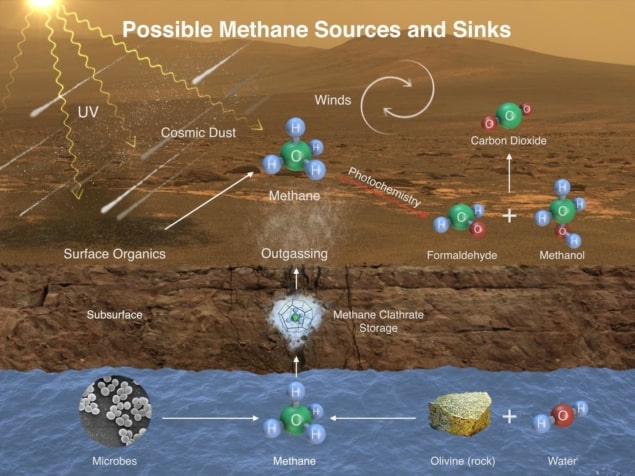
A mysterious mechanism acting on, or near, the surface of Mars is removing methane from the planet’s atmosphere, according to new results from the ExoMars Trace Gas Orbiter (TGO). The joint European–Russian mission has released interim results covering the period of April to August 2018, revealing that it did not detect methane in the red planet’s atmosphere during that time.
This seems surprising, since NASA’s Curiosity rover, situated in Gale Crater, has detected a constant average background level of 0.4 ppbv (parts per billion by volume) of methane in the atmosphere for the last three Martian years, punctuated by occasional spikes in intensity of up to 7 ppbv. Furthermore, scientists had recently confirmed that the European Space Agency’s Mars Express spacecraft had observed one of the same spikes in methane levels that Curiosity measured in 2013, verifying the rover’s detection.
TGO detects atmospheric gases by watching how they absorb sunlight. “We should see a little dip [in the spectrum] where the methane absorption line is, but we see no dip whatsoever,” says Manish Patel of the Open University, UK, who is a co-principal investigator on TGO’s NOMAD spectrometer, and a co-author of the new findings. “It’s pretty obvious that there is no methane there.”
The new results set an upper limit of 0.05 ppbv of methane, which is the limit of TGO’s sensitivity. But, says Marco Giuranna of the National Institute of Astrophysics in Rome, they are not necessarily contradictory to previous findings from Curiosity and Mars Express, and nor are they unexpected. Instead, he says, they are “two parts of the same story”.
Giuranna led the Mars Express observations that confirmed the Curiosity detection of a spike in methane on 16 June 2013. However, he points out, in that study “we did not detect any other methane aside from that one single definite detection”. Indeed, on many previous occasions neither the rover nor Mars Express have detected methane; it took two years after Curiosity landed in 2012 for it to detect methane for the first time.
“The presence of methane on Mars is likely characterized by small, short emissions and transient events, rather than by large emissions and a global presence,” Giuranna told Physics World.
Methane removal
The origin of methane on Mars has remained uncertain ever since it was first observed in 2003, with both geological and biological mechanisms being considered. The new TGO results now make the fate of that methane a mystery too. After all, methane should survive in the Martian atmosphere for three centuries before solar ultraviolet light destroys it.

The observation that any methane seems to vanish almost instantly means some unknown mechanism must be at work that “destroys or sequesters methane in the lowest part of the atmosphere,” says Giuranna. Theories have already been put forward to explain this process, including the possibility that methane could be attaching itself to eroded grains of quartz that blow in Mars’ winds, and absorption by regolith [dust] on the surface.
There is also the possibility of a biological solution, although Patel – who is Chair of the Astrobiology Society of Britain – is sceptical. He points out that there are organisms on Earth, called methanotrophs, that use methane to metabolize, but to account for the removal of all the methane on Mars, methanotrophic microbes would “have to be everywhere in order to get rid of it that fast”.
Atmospheric mixing
On the ground, Curiosity has been able to confirm that methane levels rise and fall with the Martian seasons, ranging from 0.24 ppbv in winter and 0.65 ppbv in Martian summer. The problem with this explanation, though, is atmospheric circulation. Even if the release of methane into the atmosphere is localized and seasonal, mixing in the atmospheric should cause the methane to be distributed globally at an abundance detectable by TGO. While a huge dust storm that engulfed Mars between June and August 2018 reduced TGO’s sensitivity to atmospheric gases, Patel points out that the observations made before the storm – in April and May 2018 – also detected no methane. This contrasts with measurements made in June 2018 by Curiosity, which according to Chris Webster of NASA’s Jet Propulsion Laboratory (JPL) detected 0.5 ppbv of methane. This is “in agreement with expectations from our seasonal cycle to date,” comments Webster.
Whatever the mechanism for removing methane might be, Patel is confident that it won’t remain a mystery for much longer. He is awaiting observations from TGO that cover an entire Martian year – 687 Earth days – and is also planning to work in concert with the Curiosity project to create a more complete picture. Patel has already been in touch with Webster’s team at JPL to discuss coordinating observations on occasions when TGO flies over Gale Crater, with the aim of replicating what Mars Express achieved with the June 2013 spike.
“We will be able to properly answer this question after a few more [Earth] years of observations,” says Patel.
The research is published in Nature.



